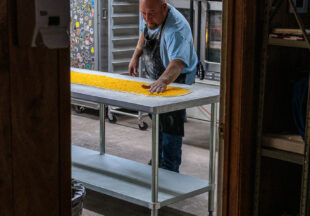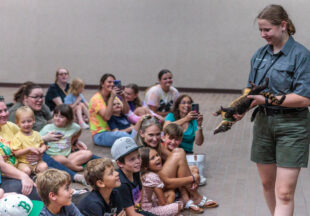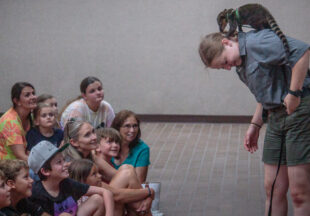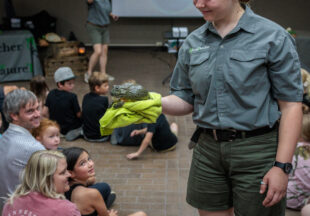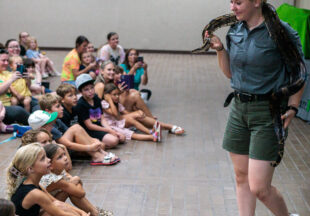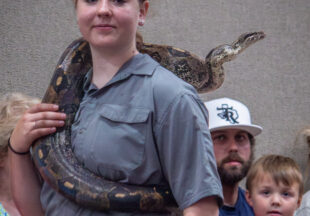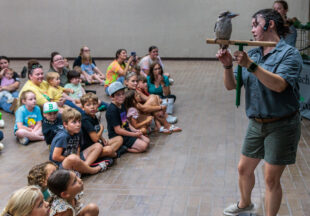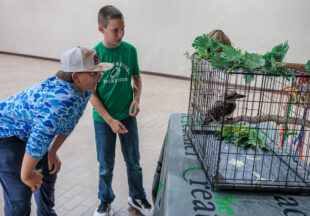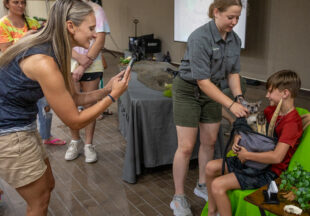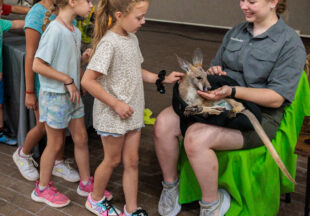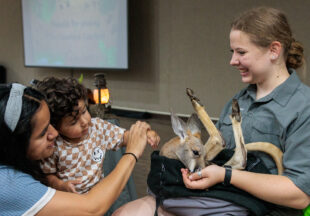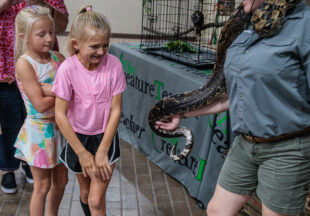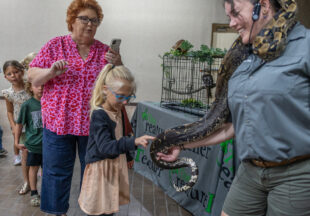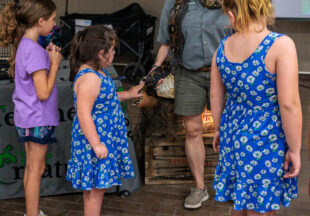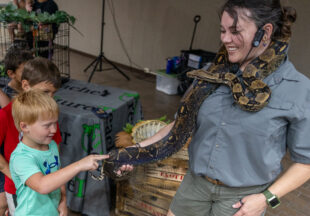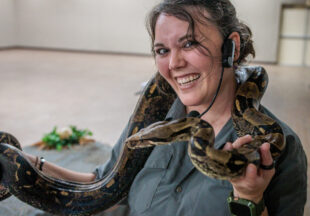New report shows hunting accidents in Texas are at a record low

By Tony Pilkington/Breckenridge Texan and TPWD Reports
Hunting-related accidents in Texas are at an all-time low since Hunter Education became mandatory in 1988, according to the 2021 Texas Hunting Accident Report recently released by the Texas Parks and Wildlife Department (TPWD).
Of more than 49,000 Hunter Education certifications in 2021, Texas experienced only one fatality and 11 accidents statewide, according to the report.
This marks a significant decrease since 1988, when more than 18,000 Texans received their Hunter Education certification but reported 12 fatalities and 70 accidents throughout the state. As more Texans have taken to the field and obtained their Hunter Education certification, these numbers have greatly improved. Even prior to Hunter Education becoming mandatory in 1988, TPWD has offered hunter education courses since 1972, certifying nearly 1.5 million students. Today, Hunter Education is required for every hunter in Texas (including out-of-state hunters) born on or after Sept. 2, 1971. The minimum age for certification is 9 years of age, and certification is good for life.
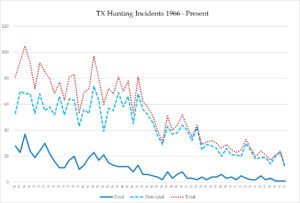
Stephens County Hunting-related accidents
The last gun-related hunting accident reported in Stephens County was on August 27, 2020. According the 2020 Hunting Accident Report by TPWD, the victim was peppered with “rat shot” to her right arm, leg, and hand, while sitting in a utility vehicle. The shooter had positioned himself on the other side of a tree to dispatch a rattlesnake. He told his wife and friend to drive out of the way, but, unbeknownst to him, he still discharged his .45 caliber handgun toward their new direction behind a brush line.
According to Stephens County Sheriff Kevin Roach, there have been no reported gun-related hunting accidents in the county in 2022 or any since he came in to office in January 2021
Most common hunting-related gun incidents
“In 2021, three quarters of the incidents were what we call ‘swinging on game outside of a safe zone of fire,’” said Steve Hall, the Hunter Education Coordinator for TPWD. “This is the most common mishap in Texas besides careless handling in and around vehicles. The cardinal rule of hunting and shooting safety is keeping the muzzle of a firearm always pointed in a safe direction.”
That sentiment is echoed by former Stephens County Sheriff Will Holt, who teaches the Texas Parks and Wildlife Hunter Education courses in Stephens County. He said muzzle control is a primary aspect he teaches in hunter education.
“Muzzle control is the number one thing, the way someone (handles) a firearm,” Holt said. “Obviously, it can be more than just hunters, but anyone that’s handling a firearm…regardless of whether the gun is loaded or not, if their muzzle…the end of the gun, is pointed in a safe direction, even if that gun goes off, nobody’s going to be harmed or killed.”
He said a gun should always be treated as if it’s loaded and anyone holding a gun should keep the muzzle pointed in a safe direction; that way, if somebody makes a mistake and the gun is actually loaded and goes off, then nobody is hit.
In the Hunting Safety class, which Holt said he primarily teaches to kids and teenagers, they are taught to never accept a gun from anybody unless you ask them if it’s unloaded and then make them prove to you that it’s not loaded.
“That means that they need to show you visually and physically that there’s no round chambered in that gun. So we do it in class, especially in the field course,” Holt said. “There’s guns handed back and forth between the students and between me and also the game warden. And every student’s probably asking, at least 10 times, somebody else if the gun’s loaded, and then making that person show them that it’s not before they ever accept it.”
Holt said he can tell the hands-on experience of handling the guns in the class really has an impact on teaching the students to how handle guns safely.
“You can tell that it does,” he said. “Because you can go through that all day long in the classroom, and they can regurgitate it…but then when you put just a little bit of pressure on them to accept the gun from somebody, and we even tell them…do not accept a gun from me just because I’m an instructor…just because he’s a game warden, don’t accept the gun from him. And so when somebody extends a gun out to a kid, and says ‘Here, hold this,’ or ‘Here, hold this while I do something,’ you can see with a lot of the kids, you can see that slight bit of hesitation about what they should say or do or ask.”
Another helpful aspect of having the hands-on gun experience in the classroom, Holt said, is just the fact the students are going through the motions of clearing a gun, working the action back and forth, showing the chamber, showing somebody how there’s no round in the chamber.
“So all that is really helpful to do in the field course,” he said. “And our students do it over and over and over. I mean, and I tell them, I kind of apologize to them, …’You might get bored, but it’s better to be bored now than dead later.’”
He said also one of the main scenarios they work on in the class is people who are getting guns in and out of vehicles.
“That’s one of the top places where hunting accidents occur is when people are getting guns in and out of vehicles and primarily because the guns are loaded when they shouldn’t be,” he said. “You’re putting them up or you’re getting them out, and the trigger gets snagged by something in the vehicle or snagged by an article of clothing. There’s even rare incidences like where bird dogs step on the trigger and the gun goes off because it should have been unloaded. So one of the areas that we work on a lot is, and it’s because the stats show it, is obtaining guns from vehicles and putting guns back in vehicles after a hunt.”
Three question to ask before shooting
Holt said there are three questions that they try to ingrain into the students to ask themselves when they’re thinking about pulling the trigger while hunting: Is it safe? Is it legal? Is it ethical?
“First thing they ask is ‘Is it safe?’ That’s the number one question…if you take that shot, is it safe? And that means is it safe to shoot because you’ve properly identified the target? Is the background safe? Is the foreground safe? Are you safe? Is the ammo in the gun safe? And so then the next question is, ‘Is it legal?’ And obviously, you don’t want to break the law, unintentionally or intentionally. And then the third question is ‘Is it ethical?’ … So, the first question that we always teach out of three is, ‘Is it safe?’ And it’s the number one question for obvious purposes.”
Avoiding Buck Fever
Although people shouldn’t be shooting at things that they haven’t fully identified, Holt said they sometimes do it out of ignorance or excitement. He said they talk about what called is Buck Fever.”
“You know, when you’re a new hunter and you see what you think’s a big buck, you start shaking and your blood’s flowing, and you start having physiological responses to seeing a deer and possibly shooting the deer and so that can cloud your judgment if you haven’t practiced over and over and over how to be safe,” he said.
Holt said, by teaching the classes, he hopes it has an impact on preventing hunting accidents in the area. “You hope that hunter safety and education keeps hunting accidents low or nonexistent in the area where you teach. And that by nothing happening, you hope that you as an instructor, that part of that is due to your influence,” he said. “My dad taught it for almost 40 years or right at 40 years before he passed away. And it gives us a sense of appreciation that, hopefully, that due to a low number of reported accidents, that the reason that’s occurring is because people are learning in the class and implementing that out in the field.”
There are two course options for anyone who needs to take Hunter Education. The basic classroom course includes six hours of instruction plus skill exercises, a review and then a final exam. These types of courses are most often held in schools or in an indoor venue. The online course, combined with a field course, has two parts: a free online course that should be completed first and then the field portion that typically takes a minimum of four hours to complete. The field course contains a presentation on ethical and responsible hunting, participation in a hunting skills trail, a live-fire exercise, a review of regulations and a final exam.
There is also an online-only course that is restricted to anyone 17 years of age or older. Online coursework varies from two to four hours depending on pre-knowledge, age, reading level and other factors.
Steve Hall, the Hunter Education Coordinator for TPWD, offers other tips that will help ensure a safe experience for hunters whether they’re at their home, in transit to their hunting spot or spending time in the field.
- Unload all firearms when not in use, especially in the home, in transport or in the field, until ready to shoot.
- Keep your fingers outside of the trigger guard until ready to take a shot.
- Waterfowl hunters should wear protective clothing, waders and approved life jackets while in boats or around water, especially in winter months. Drowning ranks as the number one hunting incident for those hunters.
- For dove, quail and pheasant hunters, the number one incident is swinging on game outside a safe zone of fire. Communicate and stick to your safe zone of fire and never shoot toward another hunter, buildings or structures, or domestic animals such as cows.
- Be sure of your target, as well as what is in front of and behind the target.
- Wear blaze orange to be seen by other hunters.
Hunters must have proof of Hunter Education certification on their person while in the field. Hunters have access to their Texas proof of Hunter Education in the free Outdoor Annual mobile app for iOS and Android.
Learn more about Hunter Education, how to sign up for a course and find resources for students on the TPWD website.
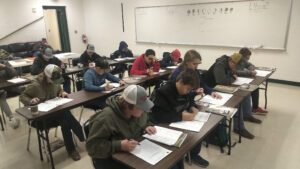
Students participate in the classroom portion of a recent Hunter Education course taught by former Stephens County Sheriff Will Holt. (Photo courtesy of Will Holt)
Cutline, top photo: Students show off their graduate stickers and their stickers featuring the four C’s of hunting — Courtesy, Careful, Capable and Considerate — after completing a Hunter Education course with Texas Game Warden Cliff Westbrook, back left, and Will Holt, back right. (Photo courtesy of Will Holt)
Make sure you don’t miss any of the Breckenridge Texan’s news…click here to sign up for our email newsletter, the Weekly News Roundup. It has links to stories, photo galleries and more! It’s free to sign up, and it comes to you on Monday mornings (sometimes on Tuesdays after a holiday).













